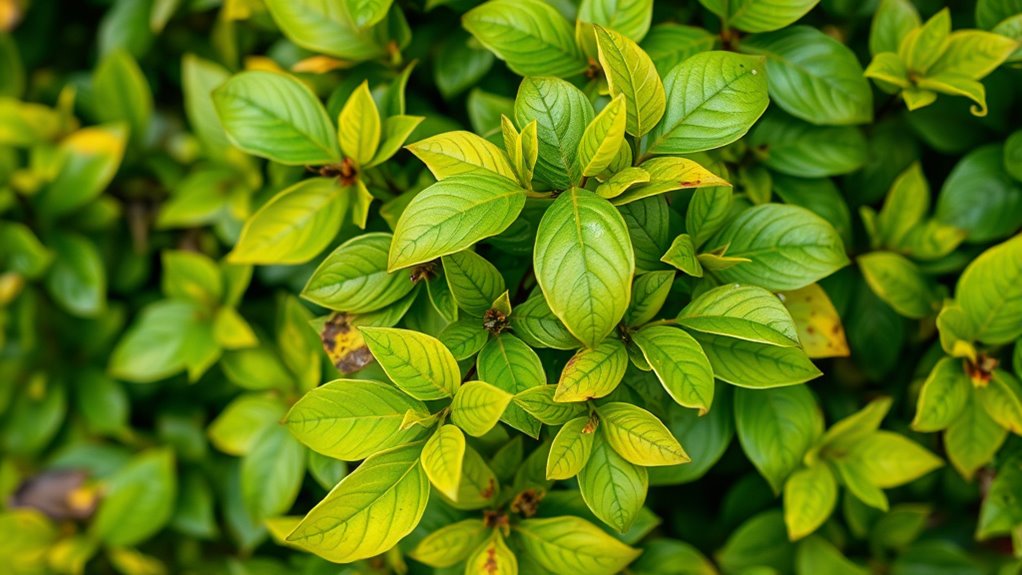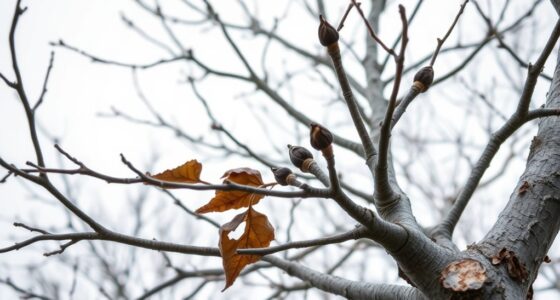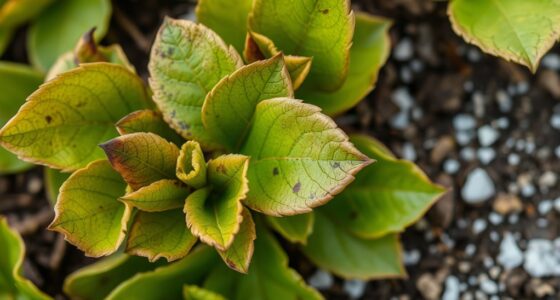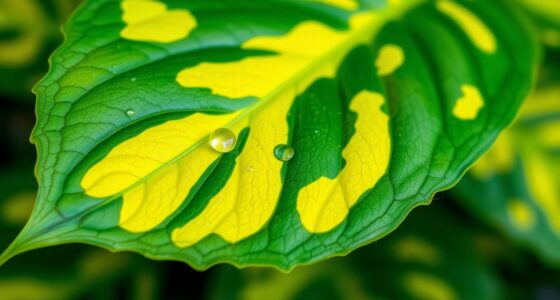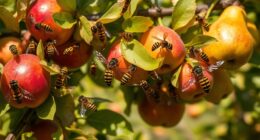If your Sunshine Ligustrum is losing leaves, it could be due to environmental stress like temperature fluctuations, improper lighting, or poor soil conditions. Pest infestations or diseases might also cause leaf drop, along with watering issues or nutrient deficiencies. Regularly check soil moisture, inspect for pests, and guarantee your plant isn’t exposed to extreme temperatures or improper sunlight. For more detailed causes and solutions, explore ways to diagnose and treat your plant’s stress signals effectively.
Key Takeaways
- Environmental stress from temperature fluctuations, inadequate sunlight, or poor soil conditions can cause leaf drop.
- Pest infestations like aphids or spider mites may damage new growth, leading to leaf loss.
- Overwatering or underwatering can stress roots, resulting in leaf discoloration and shedding.
- Nutrient deficiencies, especially nitrogen or iron, often manifest as yellowing or pale leaves.
- Regular inspection, proper watering, pest control, and soil testing help diagnose and treat leaf loss effectively.
Recognizing Signs of Environmental Stress

Environmental stress often manifests through visible changes in your sunshine ligustrum, such as leaf drop or discoloration. These signs can indicate issues like poor soil conditions or pest problems. To address potential causes, focus on pest management to eliminate pests that may weaken your plant. Additionally, guarantee proper soil aeration; compacted soil can suffocate roots and hinder nutrient uptake, making your shrub more vulnerable. By maintaining healthy soil through aeration, you improve root health and reduce stress. Keep an eye out for uneven leaf color or excessive shedding, which may signal environmental stress. Ensuring proper soil conditions is essential for the plant’s resilience against environmental stress. Regularly monitoring soil moisture and pH can further help in preventing stress-related symptoms. Addressing these factors promptly helps your sunshine ligustrum recover and thrive, preventing further leaf loss and promoting overall plant vitality.
Identifying Pest and Disease Infestations

When you notice your sunshine ligustrum dropping more leaves or showing uneven color, pests and diseases might be to blame. To identify pests, look for signs like sticky residue, webbing, or tiny insects on new growth. Disease symptoms, such as spots, mold, or wilting, can also indicate infection. Recognizing these early helps prevent further damage. Use this table to guide your pest identification and disease symptoms:
| Pest Identification | Disease Symptoms | Emotional Impact |
|---|---|---|
| Aphids on leaves | Leaf spots | Frustration |
| Spider mites on stems | Wilting | Anxiety |
| Scale insects | Mold or fuzz | Concern |
Spotting these signs promptly allows you to act quickly, saving your plant’s health and your peace of mind. Additionally, understanding Kia Tuning options can help you optimize your vehicle’s performance and appearance if you’re also caring for your outdoor space.
Assessing Watering and Soil Conditions
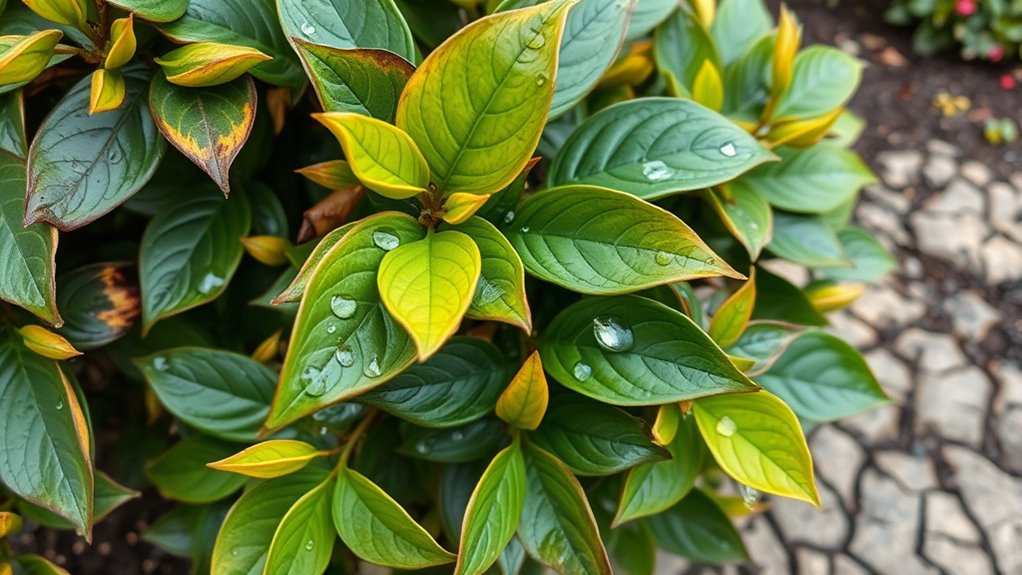
To keep your sunshine ligustrum healthy, maintaining proper watering and soil conditions regularly is vital. Start by checking your container watering habits—overwatering can lead to root rot, while underwatering causes stress. Make certain the soil drains well and stays consistently moist, but not soggy. When pruning, use proper techniques to remove dead or damaged branches, which improves airflow and reduces disease risk. Use sharp tools to make clean cuts and avoid damaging healthy tissue. Regularly assess soil moisture levels with a finger test or moisture meter to prevent extremes. Adjust watering frequency based on the season and weather conditions. Proper soil and watering practices help keep your plant resilient and prevent leaf loss caused by stress or poor root health. Incorporating the right shower fixtures can also contribute to overall plant health by reducing humidity and water spillage in your bathroom. Additionally, understanding watering techniques that suit your specific plant type can significantly enhance its health and appearance. Monitoring soil pH levels can further optimize nutrient availability and prevent deficiencies that lead to leaf drop.
Understanding Sunlight and Temperature Effects
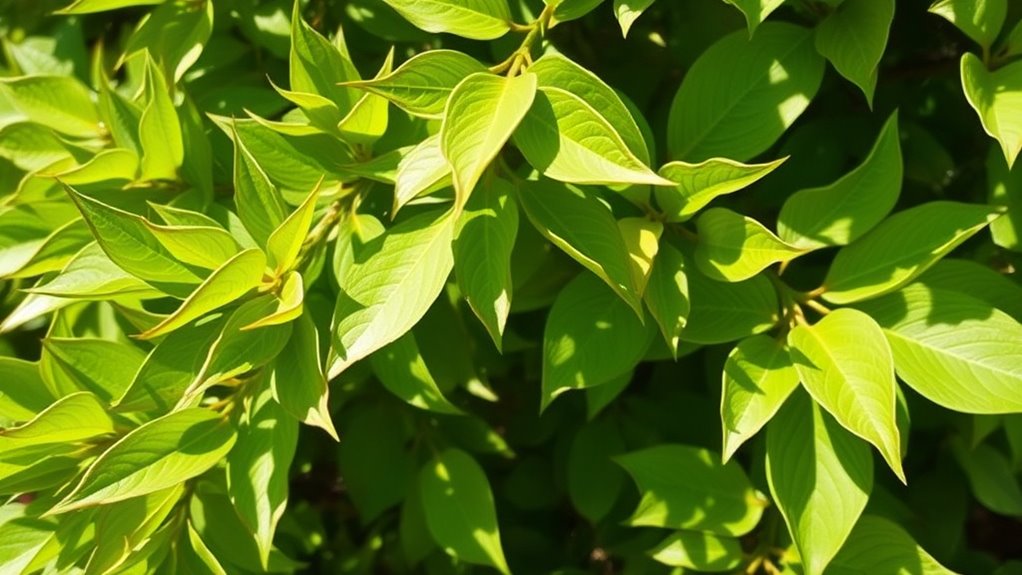
You need to pay attention to how much sunlight your Sunshine Ligustrum gets, as too much or too little can cause leaf loss. Temperature fluctuations, especially sudden changes, can stress the plant and lead to leaf drop. Understanding these factors helps you create the right environment for healthy, thriving growth. Additionally, maintaining appropriate light conditions can prevent stress and promote foliage health. Being aware of seasonal variations in sunlight and temperature can further aid in optimizing your plant’s care. Proper plant environment management is essential for preventing issues that lead to leaf loss and ensuring your Sunshine Ligustrum remains healthy.
Sunlight Intensity Impact
Sunlight intensity plays a crucial role in the health of your Sunshine Ligustrum, directly affecting its leaf retention and overall vitality. Proper sunlight exposure ensures your plant receives enough light to support photosynthesis without causing stress. Too much light, especially during peak hours, can scorch leaves, leading to leaf drop. Conversely, insufficient light reduces growth and causes leaves to yellow and fall. Light intensity influences how your plant responds; high light levels promote lush foliage, while low light results in sparse leaves. Adjust your plant’s placement based on its needs, ensuring it gets adequate but not overwhelming sunlight. Observing how your Sunshine Ligustrum reacts to different light conditions helps you optimize its environment for healthier, fuller foliage. Additionally, proper light exposure can encourage diverse crochet styles for locs, which is a creative way to enhance your personal style. Understanding plant light requirements can further assist in maintaining your plant’s health and vibrancy. Ensuring your plant receives appropriate light levels also helps prevent issues like leaf drop and promotes overall resilience.
Temperature Fluctuation Effects
Temperature fluctuations can substantially influence how your Sunshine Ligustrum responds to sunlight exposure. Sudden shifts in temperature, especially during seasonal changes, can cause temperature stress that weakens the plant. When temperatures drop unexpectedly, the plant may go into shock, leading to leaf drop and overall decline. Conversely, extreme heat during summer can cause dehydration and leaf scorch. These fluctuations make it hard for the Ligustrum to maintain steady growth, as it struggles to adapt quickly. Maintaining a steady climate is essential for the health of your plant and can prevent unnecessary leaf loss. Providing appropriate protective measures during extreme weather conditions can help your plant better withstand temperature swings. Understanding these effects helps you create a stable environment, reducing leaf loss caused by seasonal temperature swings.
Detecting Nutrient Deficiencies and Imbalances
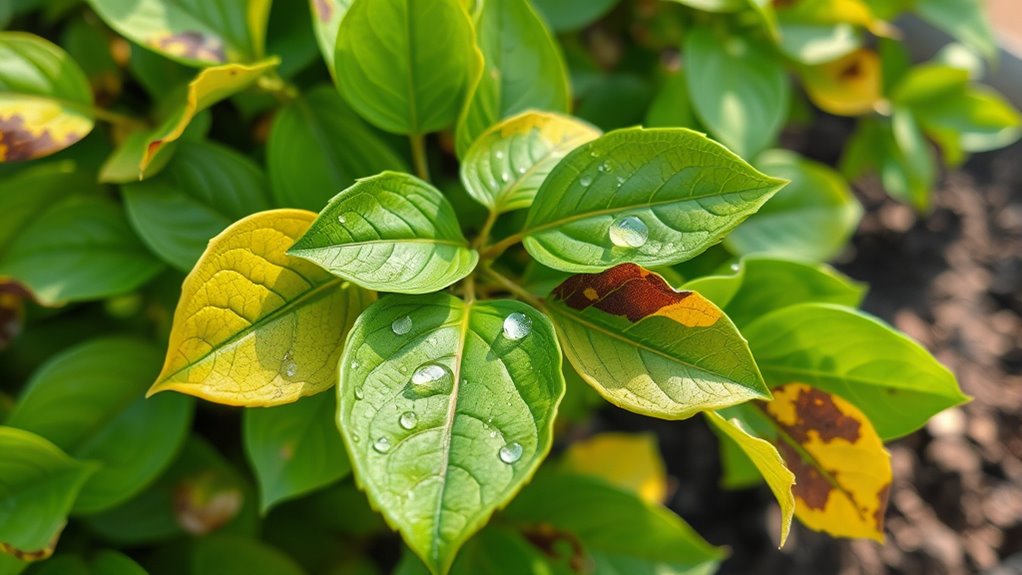
You can spot nutrient deficiencies by observing changes like yellowing leaves or stunted growth. Soil testing methods, such as test kits or lab analysis, help identify specific nutrient levels. Once you know the issues, you can apply the right corrective strategies to restore balance and health. Additionally, understanding remote work benefits can inspire you to create a more comfortable and productive environment for your gardening activities at home. For instance, selecting the appropriate keto-friendly ingredients can support your overall health and energy levels, aiding in your gardening efforts.
Signs of Nutrient Deficiency
Recognizing nutrient deficiencies in your Sunshine Ligustrum is essential for maintaining its health, as symptoms often manifest through specific leaf changes. Yellowing leaves can indicate nitrogen deficiency, while purple or reddish hues may signal phosphorus shortages. Pale or pale-green foliage might suggest iron deficiency, and leaf curling or browning edges often point to potassium issues. By observing these signs, you can adjust your pruning techniques to remove affected growth and promote new healthy leaves. Additionally, adhering to a proper fertilizer schedule helps supply essential nutrients, preventing deficiencies before they become severe. Regular monitoring allows you to catch early symptoms and respond promptly, ensuring your Sunshine Ligustrum remains vibrant and healthy. Recognizing these signs is key to effective diagnosis and treatment. Incorporating soil testing can help identify underlying nutrient imbalances for more targeted care. Moreover, understanding nutrient deficiencies can guide you in selecting the appropriate fertilizers and amendments to support your plant’s specific needs. Proper watering techniques, including the use of self watering plant pots, can also help maintain consistent moisture levels, reducing stress and nutrient uptake issues.
Soil Nutrient Testing Methods
To accurately identify nutrient deficiencies in your Sunshine Ligustrum, conducting soil nutrient testing is crucial. You can start by testing soil pH, which influences nutrient availability; if the pH is too high or low, your plant may struggle to absorb essential nutrients. Additionally, testing organic matter levels helps determine soil fertility and overall health. Using a soil test kit or sending a sample to a lab allows you to measure nutrient concentrations directly. These tests reveal imbalances, deficiencies, or excesses, guiding you toward appropriate amendments. Regular testing ensures your soil maintains ideal conditions for healthy growth. Remember, understanding soil pH and organic matter content provides the foundation for diagnosing nutrient issues accurately, helping you take targeted corrective actions.
Correcting Imbalance Strategies
When nutrient deficiencies or imbalances are detected in your Sunshine Ligustrum, prompt corrective actions are essential to restore healthy growth. Start by adjusting your fertilizer schedule, ensuring it provides balanced nutrients based on soil test results. Incorporate proper pruning techniques to remove dead or weak branches, encouraging healthy new growth. To help you plan, here’s a quick guide:
| Nutrient Deficiency | Symptoms | Corrective Action |
|---|---|---|
| Nitrogen | Yellowing leaves | Use a nitrogen-rich fertilizer |
| Iron | Leaf chlorosis | Apply iron chelate or sulfate |
| Phosphorus | Stunted growth | Use phosphorus-enhanced fertilizer |
| Magnesium | Leaf curling | Add Epsom salt to soil |
Consistent monitoring and timely adjustments keep your Sunshine Ligustrum thriving.
Implementing Effective Care and Prevention Strategies

Implementing effective care and prevention strategies is essential to help your sunshine ligustrum recover and thrive. Start with proper pruning techniques to remove dead or diseased branches, which improves airflow and reduces disease risk. Always prune with clean, sharp tools and avoid over-pruning, as it stresses the plant. Regular fertilizer application encourages healthy growth; use a balanced, slow-release fertilizer during the growing season to provide essential nutrients. Guarantee your plant receives the right amount of water—neither too much nor too little—as overwatering can lead to leaf loss. Mulching around the base helps retain moisture and suppress weeds. By consistently applying these care practices, you’ll support your sunshine ligustrum’s health, reduce leaf loss, and promote vigorous, lush growth.
Frequently Asked Questions
Can Over-Fertilizing Cause My Sunshine Ligustrum to Lose Leaves?
Yes, over-fertilizing can cause your Sunshine Ligustrum to lose leaves. An excess of fertilizer leads to a nutrient imbalance and fertilizer overdose, stressing the plant. This stress weakens the foliage, making leaves fall prematurely. To prevent this, follow recommended fertilization guidelines, avoid overfeeding, and flush the soil with water if you suspect nutrient buildup. Proper care helps your plant stay healthy and vibrant.
How Do I Differentiate Between Natural Leaf Drop and Disease?
To tell if your Sunshine Ligustrum’s leaf drop is natural or due to disease, observe the pattern. Natural leaf drop usually happens gradually and is uniform, often in fall, with healthy new growth afterward. Disease-related leaf drop may be sudden, patchy, or accompanied by discoloration, spots, or mold. Check for other symptoms like wilting or blackened stems, and remove affected leaves to help prevent spread.
What Are the Signs of Root Rot in My Shrub?
Your shrub’s root rot can be a nightmare, spreading like wildfire if unchecked. Look for signs like wilting, yellowing leaves, and a foul smell from the soil—these point to poor soil drainage and a fungal infection. Gently check the roots; if they’re brown, mushy, or smell rotten, it confirms root rot. Improving soil drainage and treating with fungicide can save your plant from this destructive disease.
Can Pruning Promote Healthier Leaf Growth?
Pruning benefits your Sunshine Ligustrum by encouraging healthier leaf growth and overall plant vigor. Leaf pruning removes damaged or diseased foliage, which helps the plant focus its energy on new, healthy leaves. Regular pruning also improves air circulation and light penetration, reducing the risk of pests and disease. By selectively pruning, you support a fuller, more vibrant appearance, ensuring your shrub stays lush and thriving.
How Long Does It Take for Treatment to Show Results?
When it comes to your Sunshine Ligustrum’s treatment, patience is key. Usually, you’ll see signs of improvement within the treatment timeline, which can range from a few weeks to a couple of months. The recovery period varies depending on the issue’s severity and your care efforts. Stay consistent with your treatments, and don’t get discouraged; plants often bounce back when given the proper attention.
Conclusion
If your Sunshine Ligustrum keeps losing leaves, it’s likely due to environmental stress, pests, or improper care. By carefully inspecting your plant, adjusting watering, and ensuring proper nutrients, you can help it recover. Remember, plants can’t speak, but they do show signs—are you paying enough attention? With a little patience and proper care, your plant can bounce back and thrive once again. Don’t you want a healthy, vibrant sunshine in your garden?
